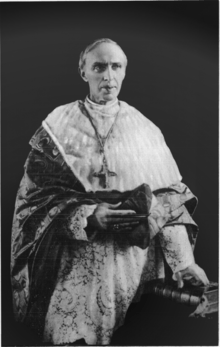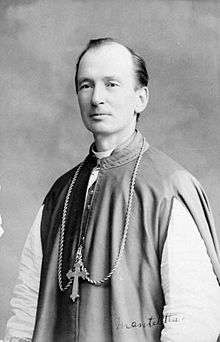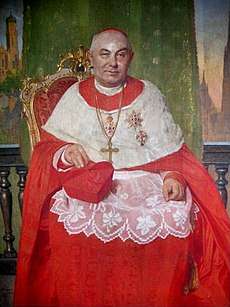Cardinals created by Pius X
Pope Pius X (r. 1903–1914) created 50 cardinals in seven consistories. Twenty of them were Italians.[1]

One of the cardinals he appointed became Pope Benedict XV.
9 November 1903

Pius created two cardinals at his first consistory, both officials of the Roman Curia. Launching his campaign to eliminate applause from religious celebrations, he was not carried into the consistory on the sedia gestatoria as was traditional. He arrived on foot wearing a cope and mitre at the end of the procession of prelates "almost hidden behind the double line of Palatine Guards through which he passed".[2] Three cardinals created at Pope Leo XIII's last consistory in June received their red hats at this consistory as well.[3]
- Rafael Merry del Val (1865–1930)
- Giuseppe Callegari (1841–1906)
11 December 1905
Pius created four cardinals on 11 December 1905, one each from Brazil, Hungary, Italy, and Spain. Arcoverde was the first Brazilian cardinal[1] and the first cardinal born in Latin America.[4][lower-alpha 1]
- József Samassa (1828–1912)
- Marcelo Spinola y Maestre (1835–1906)
- Joaquim Arcoverde de Albuquerque Cavalcanti (1850–1930)
- Ottavio Cagiano de Azevedo (1845–1927)
15 April 1907

Pope Pius created seven cardinals on 15 April 1907. This increased the number of cardinals to 62, of whom 37 were Italian.[5]

- Aristide Cavallari (1849–1914)
- Gregorio Maria Aguirre y Garcia (1835–1913)
- Aristide Rinaldini (1844–1920)
- Benedetto Lorenzelli (1853–1915)
- Pietro Maffi (1858–1931)
- Alessandro Lualdi (1858–1927)
- Désiré-Joseph Mercier (1851–1926)
16 December 1907
Pius created four cardinals in 1907, two Italian and two French. Pius spoke at length at this consistory on the persecution of the Church by the French government.[6]
- Pietro Gasparri (1852–1934)
- Louis Luçon (1842–1930)
- Pierre Andrieu (1849–1935)
- Gaetano de Lai (1853–1928)
27 November 1911

Beginning in 1907, consistories for the creation of cardinals were announced and postponed.[7] On 27 November 1911 Pius created eighteen new cardinals plus an additional one created in pectore or unnamed. Five were Italians, four French, and three American. Speculation about the one not identified centered on the Patriarch of Lisbon, António Mendes Belo, since the Portuguese Republic established in 1910 had adopted severely anticlerical policies[8] and exiled Mendes Belo from Lisbon for violating its law on the separation of church and state.[9] American representation in the College grew from one to four following the reclassification of the United States as no longer a missionary country. This included as an American Diomede Falconio, an Italian-born U.S. citizen who had spent most of his career in the United States and Canada.[7][10][lower-alpha 2] Van Rossum was the first cardinal from the Netherlands in four hundred years.[1]
Thirteen of the eighteen new cardinals attended the public consistory, where Pius praised the public demonstrations that greeted his appointments in the United States and again addressed the "weight of persecution" in France.[12]
- António Mendes Belo (1842–1929), created cardinal in pectore, announced 25 May 1914[8][13][lower-alpha 3]
- José Cos y Macho (1838–1919)
- Diomede Falconio (1842–1917)
- Antonio Vico (1847–1929)
- Gennaro Granito Pignatelli di Belmonte (1851–1948)
- John Murphy Farley (1842–1918)
- Francis Bourne (1861–1935)
- Franziskus von Sales Bauer (1841–1915)
- Léon-Adolphe Amette (1850–1920)
- William Henry O'Connell (1859–1944)
- Enrique Almaraz y Santos (1847–1922)
- François-Virgile Dubillard (1845–1914)
- Franz Xaver Nagl (1855–1913)
- François de Rovérié de Cabrières (1830–1921)
- Gaetano Bisleti (1856–1932)
- Giovanni Lugari (1846–1914)
- Basilio Pompili (1858–1931)
- Louis Billot (1846–1931), resigned from the College in 1927
- Willem Marinus van Rossum (1854–1932)
2 December 1912

At a consistory where he created one cardinal, Pius also bestowed cardinals' regalia on several cardinals created at the previous consistory: Nagl, Cos y Macho, Vico, Bauer, Almarez y Santos, Farley, and O'Connell.[14]
- Károly Hornig (1840–1917)
25 May 1914


On 26 April 1914, Pope Pius announced he would create 13 new cardinals at a 25 May consistory.[15] He announced he had made Mendes Belo a cardinal in pectore in November 1911.[1]
- Victoriano Guisasola y Menéndez (1852–1920)
- Louis-Nazaire Bégin (1840–1925)
- Domenico Serafini (1852–1918)
- Giacomo della Chiesa (1854–1922) (Pope Benedict XV; 1914–1922)
- János Csernoch (1852–1927)
- Franziskus von Bettinger (1850–1917)
- Hector Sévin (1852–1916)
- Felix von Hartmann (1851–1919)
- Friedrich Gustav Piffl (1864–1932)
- Scipione Tecchi (1854–1915)
- Filippo Giustini (1852–1920)
- Michele Lega (1860–1935)
- Francis Aidan Gasquet (1846–1929)
Notes
- For a complete list of the 59 members of the College as of March 1906 see: Keltie, J. Scott (1906). The Statesman's Year-Book: Statistical and Historical Annual of the World. London: Macmillan and Co. pp. 1285–7.
- The United States was a "missionary country" under the jurisdiction of the Congregation for the Propagation of the Faith under Pius X issued the apostolic constitution Sapienti consilio on 29 June 1908.[11]
- The Portuguese government expelled Mendes Belo from Lisbon from 1911 to 1913 for violating the Separation of Church and State law enacted 20 April 1911.[9]
References
- Murphy, Joseph J. (October 1914). "Pius X and the Cardinalate". The Ecclesiastical Review. Philadelphia: The Dolphin Press. LI: 440ff. Retrieved 20 July 2018.
- "The Pope's First Allocution". The Tablet: 778–9, 813–4. 14 November 1903. Retrieved 18 July 2018.
- de Montor, Artaud (1910). The Lives and Times of the Popes. 10. The Catholic Publication Society of America. pp. 207–8.
- "Cose Romane". La Civiltà Cattolica (in Italian). Anno 57, volume1: 103–5. 1906. Retrieved 19 July 2018.
- "Pius X Creates Seven Cardinals". New York Times. 16 April 1907. Retrieved 10 June 2018.
- "Cose Romane". La Civiltà Cattolica (in Italian). Anno 59, volume1: 98ff. 1908. Retrieved 19 July 2018.
- "To Name Three New Cardinals for America" (PDF). New York Times. 29 October 1911. Retrieved 12 November 2017. The Times describes the four French as the first cardinals from that country since the dispute between France and the Vatican [1905], but Pius had named two French cardinals in December 1907.
- Murray, Joseph J. (October 1914). "Creation and Reservation in petto". The Ecclesiastical Review. LI (4): 443. Retrieved 19 July 2018.
- Marques, Ricardo (2014). 1914 Portugal no ano da Grande Guerra (in Portuguese). Leya. Retrieved 21 July 2018.
- "Pope's Act Puzzles Church Dignitaries" (PDF). New York Times. 5 November 1911. Retrieved 12 November 2017.
- McKenna, Kevin E. (2007). The Battle for Rights in the United States Catholic Church. Paulist Press. p. 169.
- Hayes, P.J. (December 1912). "John Cardinal Farley". Historical Records and Studies. United States Catholic Historical Society. VI (2): 7ff.
- Lentz III, Harris M. (2009). Popes and Cardinals of the 20th Century: A Biographical Dictionary. McFarland. pp. 20–1.
- "Four New American Bishops". New York Times. 3 December 1912. Retrieved 18 July 2018.
- "Untitled". New York Times. 27 April 1914. Retrieved 10 June 2018.
- Additional sources
- Lentz III, Harris M. (2002). Popes and Cardinals of the 20th Century: A Biographical Dictionary. McFarland & Company. ISBN 978-0-7864-4101-3.
- Biographical Dictionary of the Cardinals of the Holy Roman Church